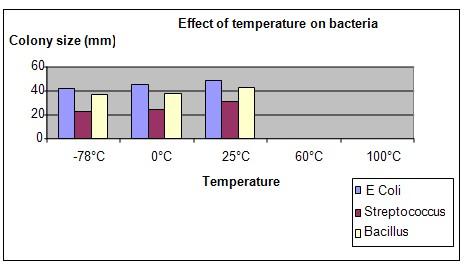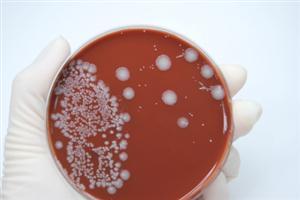| Complexity level: | 7 |
| Project cost ($): | 50 |
| Time required: | Preparation will take approximately one day, while observation and recording of data will be completed over a period of five days |
| Material availability: | Access to laboratory equipment (eg. petri dishes) |
| Safety concerns: | Always follow laboratory safety guidelines and always practice sterile technique when handling microbes. Never have any food or drink at your workstation and always thoroughly wash your hands with disinfectant soap or alcohol before leaving your workstation. Always dispose of used material in a biohazard bag. If none are available, the bacteria should be destroyed with bleach before being disposed of |
Hypothesis
Bacteria will be deactivated and destroyed at temperatures above 60 degrees Celsius.
Overview
Bacteria
Bacteria are small single-celled microorganisms that measure only a few micrometers in size and exist in various shapes such as spheres, rods and spiral. They can be found almost everywhere around us, even inside our body. . Some bacteria have also adapted, through mutation and evolution, to environments that are considered inhospitable for most living organisms, such as the earth’s crust, acidic water from hot springs and even radioactive waste.
Although most bacteria around us are harmless, some bacteria, which are known as pathogens, can spread diseases and cause people to become ill. It is therefore important to maintain our personal hygiene and to maintain a safe environment by cleaning our homes with disinfectants. However, there are also friendly bacteria which are essential for our survival, such as those that live in our stomach and intestines. These bacteria are useful in helping us digest our food.
Bacterial growth is governed by factors such as temperature, pH, salt concentration, nutrient and oxygen. The optimum temperature for most bacteria to survive and grow ranges from 25 degrees Celsius to 40 degrees Celsius, and the optimum pH ranges from 6 to 8. However, some bacteria, such as psychrophiles and thermophiles, are able to survive and reproduce under more extreme temperatures, at 0 degrees Celsius and 91 degrees Celsius respectively.
Scientific Terms
Materials
Materials required for the science fair project:
- 15 agar Petri dishes
- 15 disinfected swabs
- 1 bottle of disinfected water
- 15 test tubes and a rack
- 1 measuring cylinder
- 50 ml E Coil bacteria culture
- 50 ml Streptococcus bacteria culture
- 50 ml Bacillus bacteria culture
- 1 Marker pen
- 5 beakers
- 2 hot plates
- 3 thermometers
- 1 bag of ice
- 1 bag of dry ice
- 1 clock
Procedure
1. The independent variables in this science fair project are the temperature and species of bacteria - E Coli, Streptococcus or Bacillus. The dependent variable is the size of bacteria growth after five days, which is determined by measuring the size of bacterial growth with a ruler. The constants (control variables) are the temperature of the room, amount of sunlight, and agar preparation of the Petri dishes.
2. Store the 15 Petri dishes prepared using the agar in a refrigerator. Before the start of the experiment, take the 15 Petri dishes out of the refrigerator and allow them to warm up to room temperature.
3. Divide the 15 Petri dishes and 15 test tubes into three groups of five. Each group will contain five test tubes and five Petri dishes. Use the marker pen to label each group according to the species of bacteria that will be cultivated in it E Coli, Streptococcus or Bacillus. Next, label each of the five test tubes and Petri dishes within each group as -78 degrees Celsius, 0 degrees Celsius, 25 degrees Celsius, 60 degrees Celsius or 100 degrees Celsius.
4. Transfer 10 ml of the E Coli, Streptococcus and Bacillus bacteria culture into each of the five test tubes according to the labels made earlier.
5. Fill three beakers with water. Leave one beaker to warm up to the room temperature of 25 degrees Celsius, and place the other two beakers on two hot plates. Adjust the temperature of one hot plate to 60 degrees Celsius, and the other to 100 degrees Celsius. Next, fill the remaining two beakers are with ice cubes (0 degrees Celsius) and dry ice (-78 degrees Celsius).
6. Place three test tubes, one from each group (E Coli, Streptococcus and Bacillus), into the beakers according to the temperature markings made earlier. Leave the test tubes in their respective beaker for two hours.
7. After two hours, rinse the swab with disinfected water and dip it into the first test tube. Open the cover of the corresponding Petri dish, the one that has the same label as the test tube, and swab gently on the Petri dish. Close the cover closed and keep the Petri dish in a cool, shaded are for five days, allowing the bacteria to incubate. Repeat the procedure for the remaining 14 Petri dishes.
8. After five days, use a ruler to measure the size of the bacteria colony and record the measurements in the table given below.

Results
Bacteria that were exposed to temperatures of 60 degrees Celsius and 100 degrees Celsius were observed not to have any growth when transferred to the Petri dishes, whereas bacteria exposed to -78 degrees Celsius and 0 degrees Celsius were observed to have a significant amount of growth. Bacteria that were left at room temperature is the control group.
Hence, it may be concluded that the high temperatures such as 60 degrees Celsius and 100 degrees Celsius destroyed the bacteria, whereas lower temperatures of -78 degrees Celsius and 0 degrees Celsius are still within the optimal range of temperatures that are suitable for bacteria growth.
| Bacteria | Effect of temperature on bacterial growth | ||||
| -78 degrees Celsius | 0 degrees Celsius | 25 degrees Celsius | 60 degrees Celsius | 100 degrees Celsius | |
| E Coli | 42.5 | 45 | 49.5 | 0 | 0 |
| Streptococcus | 23.5 | 24.5 | 31 | 0 | 0 |
| Bacillus | 37 | 38 | 43 | 0 | 0 |
Use the graph below to plot the experimental data recorded in the table above.

Conclusion
The experimental data and analyzed results support the hypothesis that bacteria will be destroyed and eliminated at temperatures above 60 degrees Celsius.
Most bacteria around us are harmless, and some of them are essential for processes such as decomposition and the nitrate cycle to occur. Bacteria are also required in bioremediation for sewage disposal, and to produce dairy products such as cheese and yogurt.
Also consider
Try to repeat this science fair project by exposing the Petri dishes to different temperatures and observe the effect on bacterial growth.
The experiment can be repeated using other species of bacteria such as the Staphylococcus or Campylobacter.
References
Bacteria - http://en.wikipedia.org/wiki/Bacteria
Introduction to bacteria - http://www.umsl.edu/~microbes/introductiontobacteria.pdf

